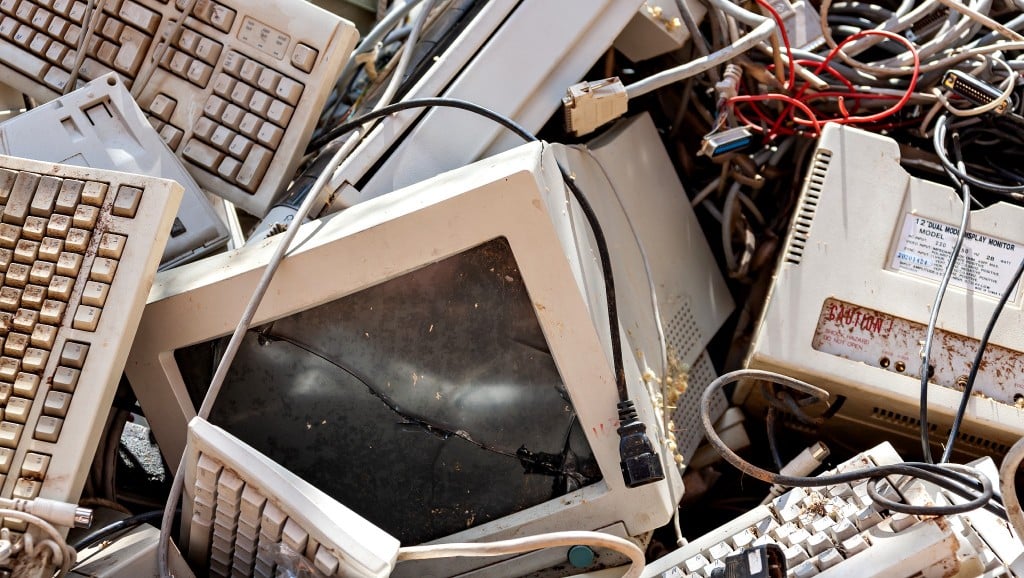10 tips for eliminating e-waste in the workplace
How to practice responsible disposal of electronics at the office

According to the Global E-waste Statistics Partnership, in 2019 the world generated 53.6 million metric tonnes of e-waste. By 2030, the number is expected to reach 74 million metric tonnes. E-waste is the term used for discarded electrical or electronic equipment, including working and broken items. Often, new and still working electronics go to waste.
One of the issues with e-waste is that it often contains toxic metals, chemicals, and pollutants. If these items are not recycled, harmful substances can contaminate landfills or water supplies, leading to environmental consequences and negative health impacts.
The world is currently working towards eliminating e-waste and saving natural resources. One of the measures that may help the issue is by understanding the environmental footprint of common e waste challenges.
Small businesses can improve e-waste in their workplaces by partnering with recycling facilities. Meanwhile, larger businesses can implement changes like choosing less toxic materials in the supply chain process, choosing to reuse materials in packaging, and implementing company wide e waste policies.
Below are 10 ways in which you can bring the circular economy into your business to reduce or manage e waste.
What is a circular economy?
A circular economy is an economic system designed to eliminate waste and pollution. The three key principles are reducing waste and pollution, keeping old electronics and materials in use, and regenerating natural systems. In addition to reducing e waste, this system creates sustainable solutions to save energy and helps avoid irreversible damage to the environment.
1. Raise awareness
To implement waste-reduction ideas and reduce the environmental impact of new devices, all departments and employees need to actively participate in sustainable practices. People tend to respond willingly and enthusiastically when they learn about the negative impact of waste on their lives.
Bring employees together to discuss how to work towards a sustainable future. Debating the subject can also help to emphasize the importance of a smart consumption model.
In the workplace, corporate responsibility can assist with finding certified recyclers in the area to curb the e waste problem in an office or workplace.
As well, one of the issues with improper disposal of electronics is the possibility of leaking sensitive data. E waste generated often has unintended consequences unrelated to the physical components of cell phones, laptops, and other electrical and electronic equipment.
2. Use incentives
By offering a small reward for the best achievements in recycling, repairing, and reusing electronic devices, business owners can stimulate the development of environmentally friendly behaviour at work and beyond.
3. Design a plan to eliminate electronic waste
Create comprehensive e waste recycling program for e scrap in stages. It's important to understand that the benefits of electronics recycling for business won't appear immediately.
One of the advantages of reducing electronic waste is appreciative clients and customers, who understand the importance of waste management. These clients are more likely to become your brand ambassadors, thus improving your marketing efforts.
4. Rethink resources
A good starting point for the circular approach is figuring out which electronic components are critical for production and which are at risk of leeching toxic chemicals. If working with plastics or natural rubber, you could start looking into less volatile options.
With the entire world trying to adopt new methods to conserve natural resources, using toxic materials and potentially risky resources could hurt your business.
By repairing and reusing end-of-life products while turning to sustainable and safe materials, you can actually improve human health on a global scale and address environmental challenges.
5. Check local regulations
Find out what local laws say about recycling, e-waste management, and how to responsibly dispose of raw materials. Existing or upcoming changes in legislation and e waste regulations can provide the necessary push towards making changes in the way a company operates.
Eliminating e waste in the workplace and introducing more environmentally friendly practices can often be difficult for some people to practice. However, the incorporation of changes can vary depending on how soon they're adopted.
6. Reconsider the supply chain
Replacing scarce valuable materials with renewable, recyclable, or biodegradable materials is the key to cutting down on e waste and creating a circular supply chain in the global marketplace.
For instance, precious metal and materials used in electronics often come from developing countries in Latin America, Africa, and the South Pacific. Extracting these items from the ground can often compromise the water and food supplies in nearby communities. Instead, finding ways to use recycled materials saves money and boosts environmental protections around the world.
7. Implement recovery and recycling
The recovery and recycling approach may be a good place to start for businesses that can't adjust the supply chain just yet. Take advantage of the latest technologies and opportunities to recover and reuse resource outputs.
Examples:
-
Walt Disney World Resort sends food waste to a recycling facility that converts it into renewable biogas, which is used to generate energy for central Florida's power supply.
-
Canon collects used equipment from the market in its take back programs, refurbishes the equipment, and re-sells it with the same guarantee as new products. The company reuses at least 80% of the materials recovered from old devices.
Small businesses can make partnerships with recyclers certified to reduce e waste. Larger companies can look into refurbishing opportunities. It's important to source products and materials that already exist within the economy instead of pulling them from ecological reserves.
8. Look at the competition
Find out how other companies are implementing e waste reudction policies in your industry. By figuring out what works for competition and what doesn't, you can have an easier time planning changes for the company.
9. Engage with partners
Engage with business partners, suppliers, and waste managers committed to reducing e waste, saving electronic devices, and reducing the creation of new toxic substances.
Be as transparent as possible about the plans to reduce unwanted electronics. Demonstrating the benefits of such a change to others can help you find sufficient funding for R&D and implementation.
10. Start with yourself
While implementing these e waste management practices for your business, make sure to follow the same principles at home. Changing your view of the environmental situation in the world can simplify the transition process. Implementing e waste disposal principles at home and in the office is a good start.
Wesley Poritz is the founder and owner of Big Sky Recycling.


